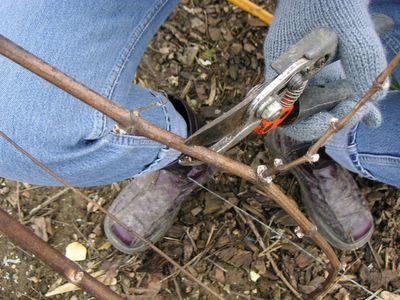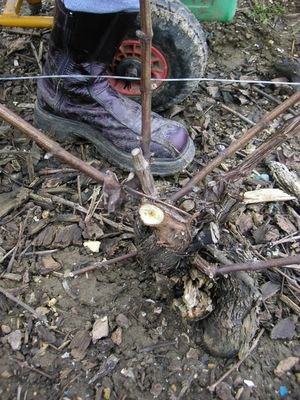
A vine with all the new shoots is a bit of a chaotic mess. But only before the pruning.
This freezing cold sunday - Saint Vincent - is the special day of celebration of the winegrowers. Meanwhile our neighbours in Verzy walk through the village with the bâton of Saint Vincent, eat a big meal and drink one glass of champagne after the other, we start the big task of pruning our vines.
The best time for the pruning is in March, but since there is a lot of work, most winegrowers must start long before in order to finish on time. In this region they say that you should only start to prune after the 22nd of January, the feast of the patron saint of the vineyards.
I take the opportunity to update my competences - not yet that extensive - before I begin as a student in the official course on how to prune the vines.
Lessons in the art of pruning coming up
The course begins in the wineschool in the village of Avize the last thursday of January. It will continue the following nine thursdays and end with a practical examination. Hopefully also with a diploma, a piece of paper, that will qualify me to the job of pruning the vines. I have no plans looking for a job in that field though. But I want to qualify as a professionnal winegrower, and this is the first step.

Courageously I remove the old charpente as part of the rejuvenation of the plant. The branch is so thick that I need the big scissors to make it. Many old vineyard workers use only the small pruning scissors since it is faster - it is also a sure way to ruin your hands too early.
To prune a vine is easy in theory. There are four different methods, and you choose according to the classification of your grapes (Grand cru, premier cru or nothing) and type of grapes (Chardonnay, Pinot Meunier or Pinot Noir).
Each type of pruning has its characteristics but the main principles remain more or less the same (Cordon de Royat is a bit different though). Below I explain the Vallée de la Marne-method, which is the one we use as our grapes are as exotic as Pinot Meunier in the Côte des Blancs-area, where you mainly find Chardonnay.

The bit with its two buds do not look like much, but actually it is quite central for the rejuvenation of the plant and its ability to keep producing grapes.
Charpente, baguette
You start with an old branch - charpente - it will have a bunch of one year old shoots, and this is where the production of grapes takes place. Grapes always grow on one year old shots, so it is important that the plant continues to develop these shoots throughout the 30 years it will at least stay in production. Only one of these shoots will survive the pruning though.
You will choose the strongest one possible and cut the top of it in a height of between six and eight buds. The main criteria for the length is that the shoot will not be allowed into the space of the neighbouring plant.
Next thing is to choose a junior amongst the one year old shoots that do not grow on the charpente. This is the baguette and its main job is to grow stronger. Only at the pruning next year and if everything has grown on the plant as anticipated, the old charpente will be removed and the baguette will replace it.
The last part is actually the most important. You seek out a third strong branch, and you remove it almost completely. Almost, because you leave a height of two buds and these two are supposed to develop shoots during the summer. One of them is supposed to take the role as next years baguette. All other shoots and brancehes will be removed, but only when you know your charpente, your baguette and your two buds. In this way you are - almost - sure to have something to fit into each part.
And this is excactly where all the problems of pruning start. You will realize that only very few vines actually fit into the beautiful theory.
Plants do not read theory
A lot can be wrong in a row of vines. Some plants are ill, some are undernourished or just weak in general. There are also the young ones, that must grow, and then the dying or even dead ones.
Some have had important branches destroyed by tractors in the summer, often because the shoots may have grown in an unfortunate direction into the path rather than along it. Some just did not develop as wanted, and others again just do not have enough good and strong branches to make it possible to prune according to the theory.

You cut the one year old baguette on the bias in a height where it has just one bud above the lower thread of the fence. A cut on the bias heals the best.
In other words you must think yourself and try to find the best solution from the possibilities that the plant will offer you. It must be pruned to secure the right amount of grapes next season, not too many, not to few. Just enough.
Knowledge is a good help
It helps your ability of making the right decisions that you have a maximum amount of knowledge. And there is a number of things that makes it much more easy to choose the right shoot from 20.

A healthy vine will produce many shoots each year. Only two will survive the pruning and it is important to choose the right ones.
To make the right decisions - preferably fast too as professionnal pruning is payment per piece - demands experience just like any other field. The more you have seen, the more you have tried, the faster and easier you can diagnose the vine. Alain does not use many seconds to read a plant and understand its strong and weak parts. Whereas I must think carefully about it before I do anything. But at least I dare to make more of my own decisions this year compared to last year. Also I am quite capable of choosing the best shoots now.
The disease is still there
During the work I find a diseased plant. What a sad sight. Almost unbearable.
Since October we have put many hours of work into the task of removing more than 400 diseased vines with branches and roots and the whole range of tools from tractors to scissors and hoe. Already on the first day of the pruning we see, that we have not succeeded to get rid of the esca yet.

The cut on a sane vine is green, where the shoot is still alive. Something black means disease.
The disease is only visible in the active period of the plant, where it shows less leaves, weak branches and less grapes of a poorer quality.
In the winter you will see the esca like a dark shade in the green cut on the pruned branch. The cut of a sane plant is all green.
På dansk
Copyright: The copyright for text and photos at bobler.blogspot.com belongs to Solveig Tange. You may use my articles, photos or parts of them for non-commercial use and if I am credited as the author. Feel free to link to this site but not in your own frameset please.

There is not much left on the vine after the pruning is finished. But there is enoughy. You just have to believe firmly in the necessity of pruning thoroughly. No doubt the most difficult part for the beginner.
No comments:
Post a Comment